List of 999 women of the Heritage Floor / Anna Maria von Schürmann
This list describes the place setting for Anna Maria von Schürmann on the table of the art installation The Dinner Party by Judy Chicago . It is part of the list of 999 women on the Heritage Floor who are assigned to the respective place settings on the table. The names of the 999 women are on the tiles of the Heritage Floor, which is arranged below the table and belongs to the art installation.
description
The installation consists of a three-sided table, each with 13 historical or mythological personalities, thus a total of 39 people, from prehistory to the women's rights movement . These people were assigned a place setting at the table, consisting of an individually designed table runner, an individually designed plate, a goblet, knife, fork, spoon and serviette. The first page of the table is devoted to prehistory up to the Roman Empire , the second to Christianization up to the Reformation and the third from the American Revolution to the women's movement. Each place setting on the table is assigned additional personalities who have received an entry on the tiles of the Heritage Floor, which occupies the space under the table and the center of the space between the sides of the table. This list includes the personalities assigned to Anna Maria von Schürmann's place setting. Your seat is on the second side of the table.
Hints
In addition to the names as they are used in German transcription or in scientific usage, the list shows the spelling chosen by Judy Chicago on the tiles.
The information on women who do not yet have an article in the German-language Wikipedia is referenced by the individual references listed under comments . If individual information in the table is not referenced via the main article, additional individual references are given at the relevant point. If there are any discrepancies between the information provided in Wikipedia articles and the descriptions of the work of art on the Brooklyn Museum website , this will also be indicated under Comments.
Place setting for Anna Maria von Schürmann
Anna Maria von Schürmann was born on November 5, 1607 in Cologne . She was a Dutch polymath and was considered "the star of Utrecht" in her day. She was widely admired for her talents. Her parents attached great importance to the education not only of their sons, but also of their daughter Anna Maria. At the age of three she read the Bible and learned the Heidelberg Catechism by heart. In addition to training a young noblewoman in the Renaissance period , she and her brothers were tutored by her father and private tutors. After moving to Utrecht and becoming acquainted with well-known painters, she also practiced painting and was taught the art of copperplate engraving. Already as a teenager she acquired a reputation for great learning. The family moved to Franeker in 1623, and their father died a short time later. Her brothers studied at the university . Through her brother Johan Gotschalk she got in contact with their professors, because as a woman she was not allowed to attend lectures. The family returned to Utrecht in 1626 and joined the community, whose presbyter was the famous humanist Arnoldus Buchelius . She was in correspondence with him, and she continued her education for the most part on an autodidactic basis. She spoke and wrote at least ten languages, was experienced in embroidery , glass painting , woodcutting and the art of copper engraving , worked as a painter, especially as a portraitist, was a virtuoso in music , poet, geographer, astronomer, theologian, pedagogue, historian, linguist and philosopher.
The Utrecht University was founded in 1636 and Schürmann was at the time the most learned woman in Europe. She was invited to write award poems for the opening. In these she denounced that women were not admitted to these “holy halls of learning”. These poems were printed along with the award poems of other scholars and were their first printed works. According to her award poems, she was given access to the university, she was allowed to take part in the lectures and disputations of all faculties, but had to sit behind a curtain in a wooden shed, invisible to the male students. She dealt with Judaism and Islam . She also copied the Koran in Arabic and wrote a grammar for the ancient Ethiopian language . In addition to languages, she was also interested in theology.
Schürmann began to publish writings, letters and poems. She dealt with the issue of education for women, and her writings were widely circulated. Her fame drew scholars from all over Europe with whom she corresponded, visited, and wrote the award poems about her. As an artist, she portrayed several members of the university and was accepted into the Guild of St. Luke in 1643 . Von Schürmann motivated other women to also educate themselves humanistically. One of the visitors in 1654 was Christina of Sweden , who came to Utrecht disguised as a man and had Anna Maria von Schürmann portray her as Pallas Athene . After her mother's death in 1637, she ran the household to her brother Johan Gotschalk. Thanks to her wealth, she had a carefree life and she was able to participate in his studies, as no other university allowed her access. In 1653 she traveled to Cologne with her brother. There they supported two of their mother's sisters and, as Calvinists, had to live their religion in secret in Catholic Cologne.
Since Schürmann came from a pious, Calvinist house, theology also determined a large part of her studies and for her it meant above all piety in practice. After her stay in Cologne, the desire increased in her to sacrifice life to faith. She restricted her contacts and moved with her brother and aunts to Lexmond, where the family owned land and lived there for two years in isolation. She returned to Utrecht after the death of her aunts and a life-threatening illness. Her brother Johan Gotschalk introduced her to Jean de Labadie , whom he had met in Geneva after receiving his doctorate in Basel in 1662. After the death of Johan Gotschalk in 1664, Anna Maria continued the correspondence and Labadie came to Utrecht in 1666. She then accompanied him on his preaching trips. She sold her house in Utrecht in 1669 and joined the Labadists. She revoked her earlier writings and only wanted to devote herself to enlightenment and church work. This caused quite a stir. With the Labadists she moved to Amsterdam and on to Herford in Westphalia. She published the first part of her autobiography, Eukleria, or the Election of the Better Part , in 1673. Labadie died in Altona near Hamburg in 1674 , and Schürmann became the spiritual leader of the group. They moved to Wieuwerd in West Frisia and found refuge in Walta State. There she died in 1678 a few days after completing the second part of her autobiography Eukleria .
The table setting of Anna Maria von Schurmann is held in orange tones. The plate has an abstract butterfly shape that seems to flow towards the edges. The table runner is divided by many rectangles. In these small scenes of the Dutch tradition are shown. Young girls had to practice the tiny stitches on these small rectangles and thus were taught the feminine virtues such as docility and obedience. After Chicago, girls were so forced to “think small” during this time. On the back of the table runner there is an embroidered flower basket, a common motif in Dutch embroidery, which means renewal. Windmill, ship, house and other motifs surround the flower basket. The front shows further small embroidery pictures in a lower border. The name Anna Maria von Schürmann, on the other hand, is surrounded by angels who indicate her role as religious leader. The initial letter "A" is decorated with the same motif that can be found on the plate. In her work, Anna Maria von Schürmann fought against the restriction of women to domestic life. One of her most famous quotes is embroidered on the runner in English: “The woman has the same upright face as the man, the same ideals, the same love for beauty, honor and truth, the same desire for self-development, and yet she should be in be trapped in an empty soul whose windows are closed. "
| Surname | Spelling on the tile | Date of birth | cultural spatial assignment | Remarks | image |
|---|---|---|---|---|---|
| Ann Baynard | Anne Baynard | around 1528 | England | British natural philosopher who was held up as a model of piety. She particularly appealed to her own gender to make an effort to educate themselves. | |
| Anna Amalia from Braunschweig-Wolfenbüttel | Anna Amalia | 1739 | Saxe-Weimar-Eisenach | Princess and composer, became Duchess of Saxe-Weimar-Eisenach by marriage and was regent of Saxe-Weimar and Saxe-Eisenach from 1758 to 1775 . She transformed her farm and its surroundings into the most influential cultural center in Germany. |

|
| Anne Askew | Anne Askew | 1521 | England | Protestant martyr . |

|
| Anne Dacier | Anne Dacier | 1647 | Kingdom of France | Translator and writer of Huguenot descent. |

|
| Aphra Behn | Aphra Behn | 1640 | England | Writer, spy and feminist. She occupies a unique position in English literature because she was the first public professional writer in England and played an important role in the development of the modern novel . |
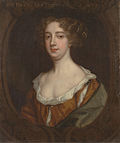
|
| Barbara Uthmann | Barbara Uttman | around 1514 | Duchy of Saxony | Entrepreneur in the Ore Mountains . |

|
| Bathsua Makin | Bathsua Makin | 1600 | England | Early women's rights activist , teacher and scholar, campaigned for a comprehensive education for girls and women and founded a co-educational school. |

|
| Bernarda Ferreira de Lacerda | Bernarda de la Cerda | 1596 | Kingdom of Portugal | Scholar, writer and playwright whose skills have been celebrated in the verses of the poets Manuel de Gallegos and Lope de Vega . | |
| Birgitte Thott | Bridget Tott | 1610 | Denmark | Writer, scholar, translated the Roman classics into Danish. |

|
| Caritas Pirckheimer | Charitas Pirckheimer | 1467 | Duchy of Franconia | She was an advocate of freedom of religion and conscience and resisted the enforcement of the Reformation in her monastery. |
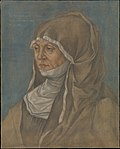
|
| Elena Lucrezia Cornaro Piscopia | Helen Cornaro | 1646 | Republic of Venice | Benedictine oblate and scholars. She was the first woman in the world to receive a doctorate . |

|
| Glikl bas Judah Leib | Happiness from Hameln | 1645 | Hamburg | Merchant who was the first woman in Germany to write an important autobiography that has survived . |
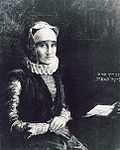
|
| Hannah Woolley | Hannah Woolley | 1621 | England | Cookbook author whose works have been printed. Her books also deal with general housekeeping . |

|
| Hortensia Gugelberg from Moos | Hortensia of moss | 1659 | Switzerland | Doctor, journalist, researcher and writer from the canton of Graubünden . |

|
| Izabela Czartoryska | Isabela Czartoryska | 1746 | Kingdom of Poland | Aristocrat, art collector and writer. She founded Poland's first museum, the Czartoryski Museum in Krakow . |

|
| Jeanne-Marie Bouvier de La Motte Guyon | Jeanne Marie Guyon | 1648 | Kingdom of France | Representative of mystical quietism . |

|
| Laura Bassi | Laura Bassi | 1711 | Bologna | Philosopher, Europe's first female university professor for physics , held a professorship for philosophy . |

|
| Lucretia Marinelli | Lucretia Marinelli | 1571 | Republic of Venice | Renaissance writer , questioned the arguments against female self-determination that were common at the time , opposed the Aristotelian image of women and critically examined the story of creation. | |
| Luisa de Carvajal y Mendoza | Luisa de Carvajal | 1566 | England | Member of the Spanish nobility, religious poet and writer who wanted to evangelize Catholic doctrine in England. |

|
| Luise Adelgunde Victorie Gottsched | Luise Gottsched | 1713 | Electorate of Saxony | Early Enlightenment writer . |

|
| Maria Antonia of Bavaria | Maria Antonia Walpurgis | 1724 | Electorate of Saxony | Princess from the house of the Wittelsbach family , wife of the Elector of Saxony , regent until her son Friedrich August came of age , also an art patron , composer , opera singer , painter and poet . |

|
| Maria Gaetana Agnesi | Maria Agnesi | 1718 | Duchy of Milan | Mathematician and philanthropist in the Age of Enlightenment . |
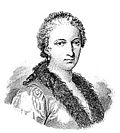
|
| María from Ágreda | Maria de Agreda | 1602 | Kingdom of Castile | Visionary and abbess of the Franciscan convent in Ágreda . |

|
| Marie de Gournay | Maria Le Jars de Gournay | 1565 | Kingdom of France | Writer , philosopher and women's rights activist . |

|
| Marie de Miramion | Marie de Miramion | 1629 | Kingdom of France | Known for her piety and the organizations she founded. | |
| Mary Astell | Mary Astell | 1666 | England | Writer , rhetorician , philosopher , advocated giving women the same educational opportunities as men with equal abilities, called for the abolition of inequality in marriage, is considered the “first English feminist ”. | |
| Soror Mariana Alcoforado | Marianna Alcoforado | 1640 | Kingdom of Portugal | Nun and writer , the five most beautiful love letters in the world are ascribed to her, the Portuguese letters . |

|
| Susanna Lorántffy | Susanna Lorantffy | 1602 | Kingdom of Hungary | Supporter of the Reformation and benefactress and wife of Georg I. Rákóczi . |
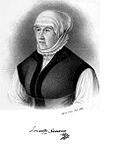
|
- Individual evidence
- ^ Brooklyn Museum: Anna van Schurman. In: brooklynmuseum.org. Retrieved October 27, 2019 .
- ^ Brooklyn Museum: Anne Baynard. In: brooklynmuseum.org. Retrieved October 27, 2019 .
- ^ Brooklyn Museum: Bernarda de la Cerda. In: brooklynmuseum.org. Retrieved October 27, 2019 .
- ↑ Brooklyn Museum: Bridget Tott. In: brooklynmuseum.org. Retrieved October 27, 2019 .
- ↑ Brooklyn Museum: Luisa de Carvajal. In: brooklynmuseum.org. Retrieved October 27, 2019 .
- ↑ Brooklyn Museum: Marie de Miramion. In: brooklynmuseum.org. Retrieved October 27, 2019 .
Web links
- Brooklyn Museum, Anna Maria von Schürmann
- The Dinner Party on the website of Through the Flower , Judy Chicago's non-profit organization
